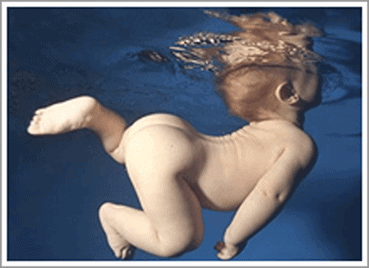Woman’s Day – Benefits of Infant Swimming Classes Go Beyond the Pool
Katrina Vella
Tuesday, December 15, 2009

The 2009 National Drowning Report found that almost 60 percent of children under the age of five who had drowned had lost their lives in a backyard swimming pool.
Baby Steps with Swim Training
One way of stopping more and more children becoming part of this statistic is to teach children to swim at an early age — and a very early age at that.
A strong believer in teaching children to swim from birth, professional swimming coach Laurie Lawrence says teaching children to swim and become familiar with water could potentially save their lives and has major benefits on a child’s growth and development.
Laurie’s granddaughter has been being taught to swim since she was just four days old.
“My granddaughter at four days with her umbilical cord still attached was having water poured over her face,” Laurie says.
“Children are in the womb, they are swimming for nine months so you are just continuing that natural affinity,” he says.
“And while you are pouring water over their face you use trigger words so they respond to these verbal triggers and can soon learn to hold their breath on their own on command using these triggers.”
Laurie says his granddaughter at four months old was able to hold her breath on command by using the trigger “easy, ready, go”. He says the trigger needs to be rhythmically constant every time it is said for a child to familiarise themselves with it and what it means.
“Breath control is the first stage of any learn-to-swim program so babies are able to learn to swim from birth,” Laurie says.
“Just as parents talk to their babies from birth, the more you talk to them and read to your baby, the smarter and more familiar with talking they become.”
Laurie says the most important thing that children learn through swimming lessons is to be safe around water.
“Children who have swimming lessons realise how to become safer around water, because they begin to understand the difference between deep and shallow water and they are less likely to go into threatening situations,” he says.
He says there are four major benefits which he has observed of teaching children to swim from a young age or from birth.
Four Major Benefits to Child Swim Teaching
One: Those children who have swimming lessons at an early age, if parents continue these lessons, will have better developed motor movement. In other words they can coordinate their motor movement much better than those who don’t swim.
Two: Because these young children or babies are in lessons and they have to follow instructions, they improve their cognitive skills.
Three: A child who is involved in swimming lessons will develop their social and emotional skills further because they are involved with other children.
Four: Because they are being spoken to about their movement skills in the water and spoken to about colour, their language skills are developed.
Queensland’s Griffith University is currently undergoing a study into these four benefits of children learning to swim from a young age which Laurie has observed.
And it’s not just the swim school teachers who are involved in the process. Laurie says parents play the most important role in teaching their child to swim, just as they teach them to talk and walk.
“If it’s a parent and child activity it makes a huge difference,” Laurie says.
“The best teaching for young children is one-on-one and that’s the safest method of teaching,” he says.
“We teach the parents how to teach their child to swim and I emphasise the word swim and emphasise the importance of moving the child through the water.”
To watch the video of Laurie’s granddaughter being taught to swim visit www.babyswim.info




Leave A Comment